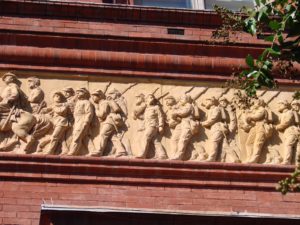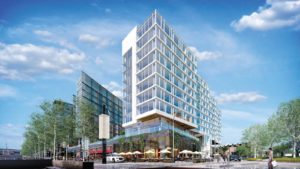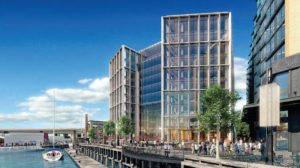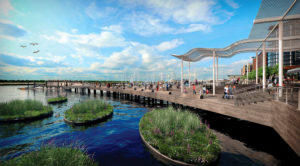Development Projects Featuring “Resilience” to Climate Change (Pt 1)

The more attention on resilience strategies/outcomes being added to our built environment the better I feel.
I blogged about resilience to climate change awhile back: “Resilience addresses shocks and stresses, and, while not geared toward any single shock or stress, anticipates a future way of life in our cities and towns that will reveal corresponding traumas. (Here’s that post.) Since then I’ve attended several presentations about the subject.
 One was held back in March at the National Building Museum in D.C. Love this building for its scale, both outside and in. The 1,200 LFT terra cotta frieze that wraps the exterior facades of this very large, historic building depicts Union armies of the Civil War. For many of its years, this 1887-completed building was known as the Pensioner Building. It housed the U.S. Pension Bureau which accounted for hundreds of thousands who fought.
One was held back in March at the National Building Museum in D.C. Love this building for its scale, both outside and in. The 1,200 LFT terra cotta frieze that wraps the exterior facades of this very large, historic building depicts Union armies of the Civil War. For many of its years, this 1887-completed building was known as the Pensioner Building. It housed the U.S. Pension Bureau which accounted for hundreds of thousands who fought.
 The title for this presentation was “Resilient Design–District Wharf.” Katherine Burgess, of ULI’s Urban Resilience Program, introduced the program. Her definition of resilience complements the one I used. Hers: “The ability to prepare and plan for, absorb, recover from, and more successfully adapt to adverse events.” Coinage of the word resilience these days often centers around extreme climate events.
The title for this presentation was “Resilient Design–District Wharf.” Katherine Burgess, of ULI’s Urban Resilience Program, introduced the program. Her definition of resilience complements the one I used. Hers: “The ability to prepare and plan for, absorb, recover from, and more successfully adapt to adverse events.” Coinage of the word resilience these days often centers around extreme climate events.
Presenters: Hilary Birtsch, architect/Perkins Eastman project manager for The Wharf; Matt Steenhoek, development vice president for PN Hoffman/associate project director for The Wharf; and, Elinor Bacon of E. R. Bacon Development.
 Overall plan of this 1-mi. long, multi-phased $2.2B waterfront “neighborhood” project of 27 acres includes these programming/design goals:
Overall plan of this 1-mi. long, multi-phased $2.2B waterfront “neighborhood” project of 27 acres includes these programming/design goals:
- Multi-modal with easy access to all public transportation
- Multiple architects and landscape designers for a range of design/overall appearance
- Use of mews/smaller streets to counter a monolithic feel
- Delineation of streets/sidewalks by textures of paver patterns and bollards for a more human-scale experience
- 1,300-space “waterproof” underground garage
- 400-ft. long District Pier
 From a strict sustainability perspective, including resilience, project goals comprise:
From a strict sustainability perspective, including resilience, project goals comprise:
- Buildings built 1-1/2′ above the new FEMA requirement of 2′ above the 100-year flood event (a 3.2″/hr. rain fall)
- Targeting LEED® ND (Neighborhood Development) Gold for the entire Wharf development; and LEED Gold or Silver for individual buildings
- Nearly half of total area devoted to neighborhood parks/public spaces
- Trees/other landscaping materials watered from cisterns
- Other rainwater reuse systems
- Substantial vegetative bioretention for stormwater runoff management
- Green roofs
 340 sq. ft. of nutrient-level-reducing floating wetlands systems [love it!]
340 sq. ft. of nutrient-level-reducing floating wetlands systems [love it!]- Multiple forms of on-site renewable energy production/conservation, including a co-gen plant, solar PV systems, and energy-efficient lighting throughout
- Neighborliness, especially for helping each other during any extreme weather event/other emergency
Other notable, resilient buildings mentioned were the Chesapeake Bay Foundation’s new Brock Environmental Center in Virginia Beach (blogged about here), and Harvard University’s Spaulding Rehabilitation Hospital, located in the Inner Harbor of Boston.
Spaulding Rehab will soon be featured in Pt 2 on this subject.
Don’t miss it. Subscribing to the blog is one way not to…